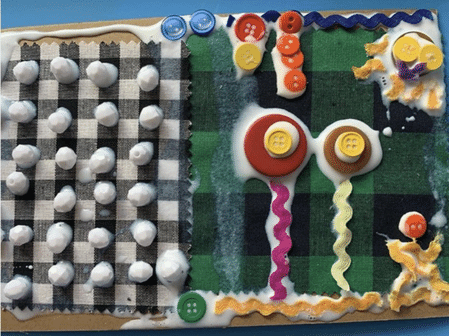Integrating Literacy and Process Art
Process Art and Literacy in Early Childhood
“Play is the work of children” - Maria Montessori
Every child is different. Children have different strengths and areas that need support, they have different interests, and they have different likes and dislikes. Nicole’s daughter was interested in writing and learning about letters from a very young age. She used to write “notes” to us that were unintelligible scribbles, but they had meaning to her, and she delighted in sharing her words. From there she began writing single letters and then moved on to invented spelling. Nicole’s son, on the other hand, did not show much interest in letters and writing at the same age. Instead, he focused on building and zooming cars and vehicles around, interests and skills that also strengthened his fine motor and early literacy skills. Both of Nicole’s children attended the same preschool which was rich in literacy while keeping the focus on play - the work of children.
Here are a few easy ways to integrate literacy and process art within the art area of your classroom.
Art Area Strategies
Labels - Create labels for items in the art area showing the material’s name and a photograph to promote children’s print awareness. Some items in your art area you may wish to label include the easel, paint, paint brushes, glue, scissors, paper, or any other supplies. Bonus - labeling items helps children to be self-sufficient during clean up times, too!
Signs - Post handwritten or typed signs and question prompts near art projects and materials. This type of sign near a project encourages children to ask caregivers what the words say. This reinforces that written words also serve as a means of communication. When hearing the words read aloud, children are introduced to new vocabulary, increasing their likelihood to later use those words when describing their artwork. For example, if there are paint sticks and foil sheets covering the table, a sign displayed might say, “What types of lines can you create on the foil?” As children work and think about this question, caregivers, and children might communicate with words like, “straight,” “curved,” “thick,” “thin,” “long,” or “short.” Having written signs encourages children to take the lead with caregivers when discussing their work.
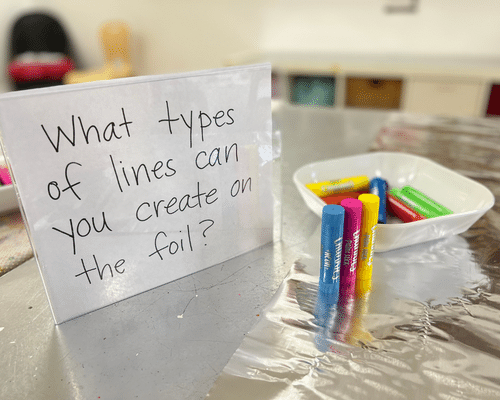
Photos of artwork with written documentation - Display photos of children’s artwork and their creative process with some written documentation. When children have the chance to view photographs of their previous work, along with written words either describing what they were doing or narrating a conversation they had while working, they learn that the words they said and the ideas they had can be translated into writing. Photographs and written documentation also allow children to revisit prior concepts and even expand on them.
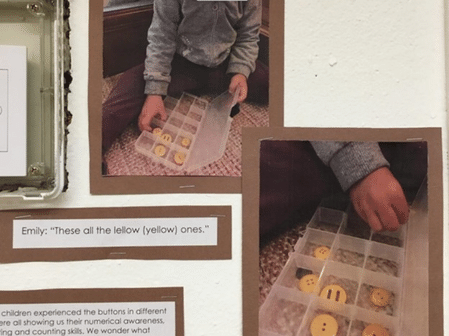
Process Art Ideas
Line Tracing - Cover your table with a large sheet of paper, table paper, or butcher block paper. Use a permanent marker to draw a variety of line shapes, that connect to each other around the paper. You may wish to draw zig zags, curlicues, up and down squares, waves, mountains, and straight lines. Place small plastic animals, corks, or other tools for stamping around your lines, along with palettes of paint. Encourage children to dip their tools into the paint colors and trace around the lines, moving from left to right, if possible. As they move along these lines, children are developing pre-writing skills as they begin to practice forming the shapes that they will later use when creating representational drawings and letters.
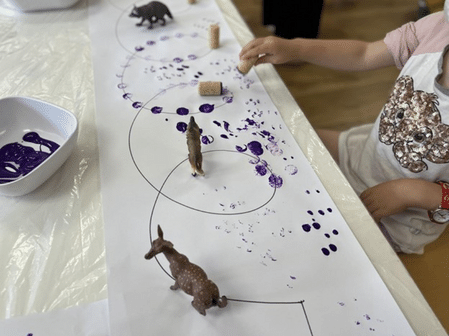
Sensory Drawing - Gather a tray or shallow dish and cover the bottom with a thin layer of salt, sand, or even paint. Encourage children to use their fingers to draw lines, shapes, or letters in the sensory base. You can provide pictures of different shapes of lines or alphabet letters as guides for them to explore or inspire. If children prefer not to touch the sensory material with their fingers, a tool such as a chopstick or a paintbrush may be used. This activity also provides an opportunity for strengthening fine motor skills.
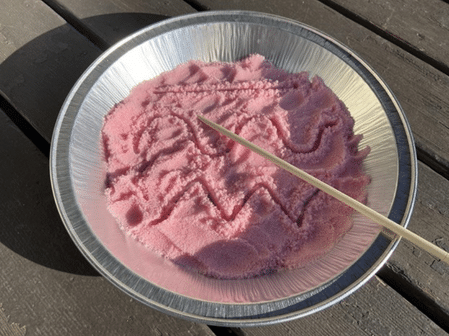
Loose Parts Stories - Offer children a variety of loose parts along with a canvas. This canvas can be a sheet of paper, fabric, or even a square taped to the table. Encourage children to play and explore with their loose parts and then arrange these pieces in a way that tells a story. Teachers can transcribe the stories children create and later share these written words orally to the creators and other children. These stories can also be displayed with photographs on the wall for others to enjoy. When children see their own words and stories written down and shared with others, they learn that thoughts and words can be shared in print as well as spoken out loud.
Storytelling Quilt Squares - This project can be done on its own or may be an extension of the loose parts storytelling activity above. Offer children squares of tagboard as a base to be used with glue, fabric, patterned paper, beads, yarn, and other materials. Discuss how some artists, such as Faith Ringgold, use this medium to tell stories. While reading and discussing, point out how familiar stories all have a beginning, middle, and end. Children can write their own stories or dictate stories to an adult, detailing what they have created with the fabric and materials provided. When Rachel’s child engaged in this project, he created a line down the middle of his canvas and used different color schemes on each side. When telling his story, he described what was happening on each side. One side was a “winter party” with snowmen and snow, while the other side was a “spring party” with colorful flowers and grass. The flowers and grass told the snowmen that their party was ending, and it was time to melt. The flowers and grass were excited that their party was just beginning! Stories like these can be typed up and glued along the borders of their quilt squares.
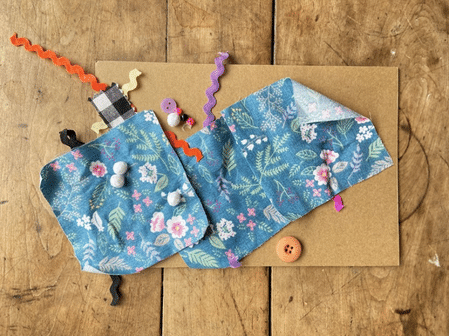
We hope these art and literacy ideas have inspired you. Please check out some of our previous blog posts to learn how other types of learning can be integrated with art and sensory play - the work of children!
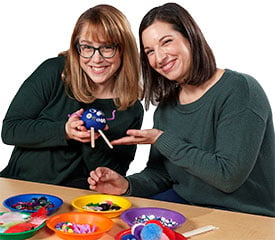
With over 30 years of combined teaching experience between them, early childhood educators Nicole Werther and Rachel Miller know just how to keep your young children engaged—let them take the lead! Their small business, Backyartists, encourages creative thinking and discovery through the magic of process art and sensory play.
Rachel and Nicole are Becker's Creative Arts Content Advisors and have used their knowledge of process art to create resources, such as blog posts and activity ideas, to inspire teachers and parents when planning projects with the Artful Goods materials.
They also offer playgroups and classes in the Boston area. Check out Backyartists.com for the most up to date offerings.

